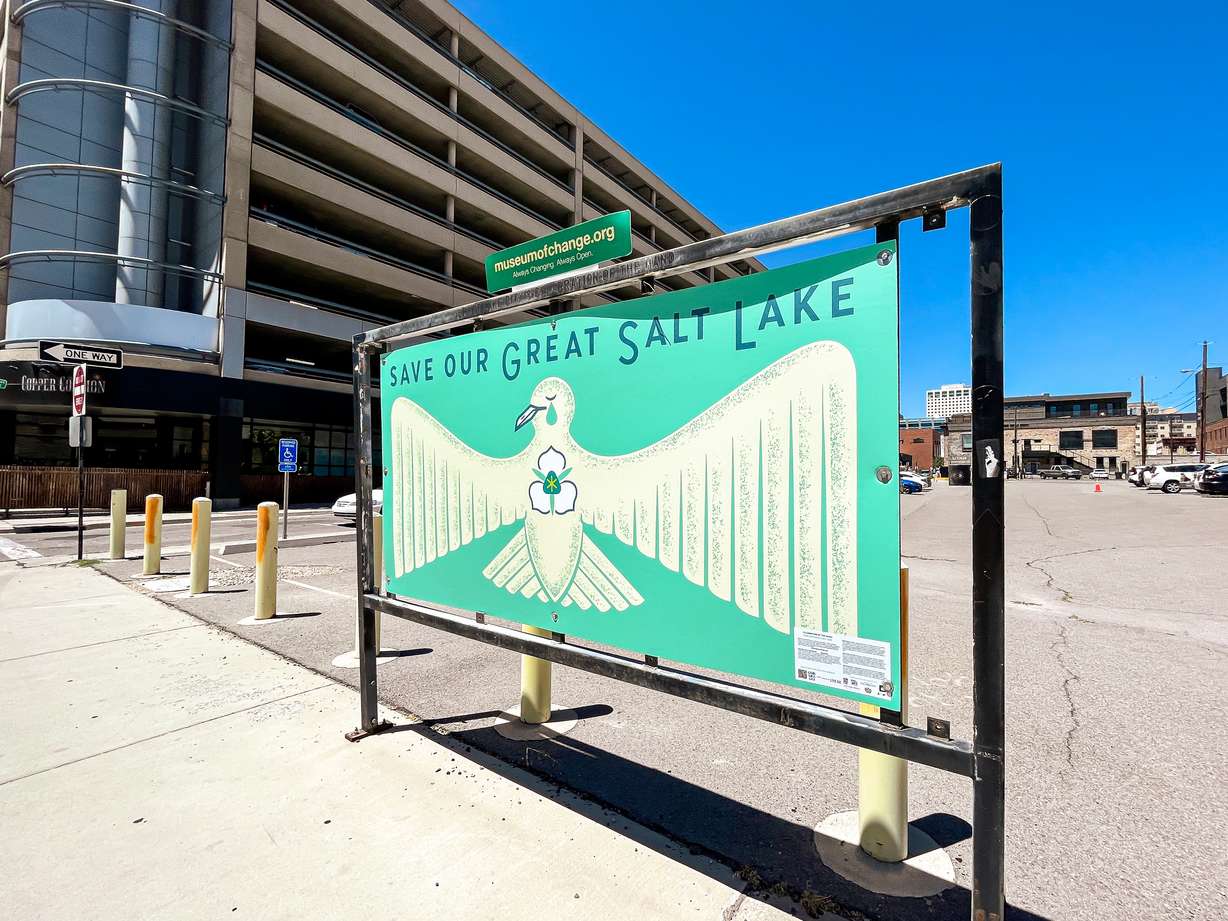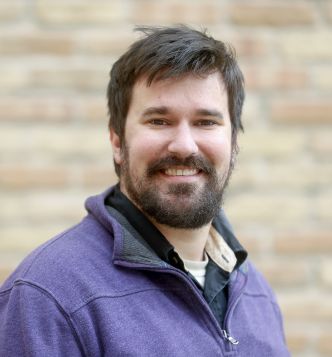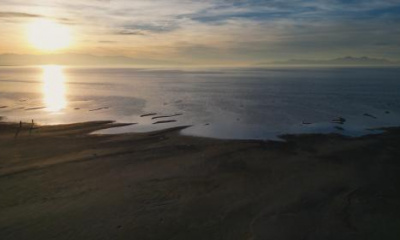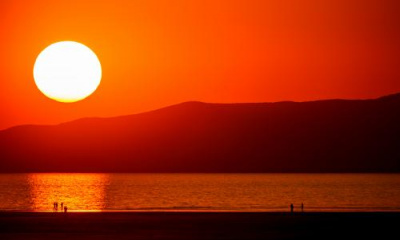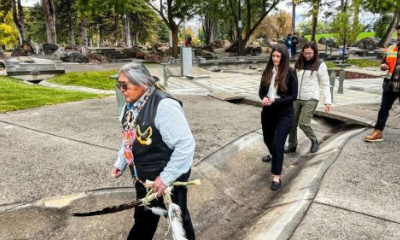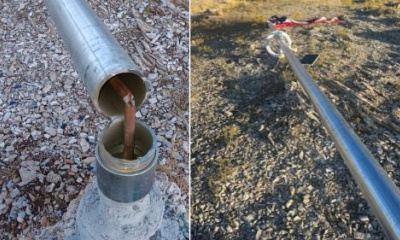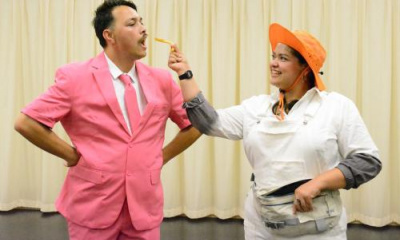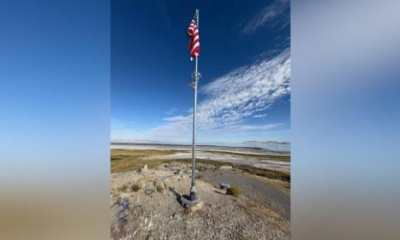SALT LAKE CITY — Jacob Brooks' latest painting is quite simple, so simple that his 3-year-old son can understand the message Brooks is trying to convey.
It's a California gull with a sego lily on its chest — Utah's state bird and flower — sprawled across the canvas. The bird is clearly sad, shedding a tear underneath the message "Save Our Great Salt Lake." It's intentionally straightforward enough that practically anyone who comes across it — even a 3-year-old child — knows that something is wrong with the Great Salt Lake because the bird is crying.
"The simplicities that I made it around were honestly geared toward the younger generation," explained Brooks, an artist who lives in Provo. "It opens up sort of a dialogue about why the seagull is sad, which (leads) to talking about our shrinking Great Salt Lake."
This is one of a little more than a dozen Great Salt Lake-themed paintings now on display across a four-block stretch of downtown Salt Lake City. They are the latest subject of a revolving public art exhibit created by the art and culture nonprofit Craft Lake City.
The organization installed the 14 new art pieces in downtown Salt Lake City during the Fourth of July weekend, all of which highlight the lake's importance, history or the looming environmental dilemma that its drying would create. The point is to raise awareness about why the lake matters, especially for those who really don't think about it too much, says Angela Brown, the executive director of the art and culture nonprofit Craft Lake City.
"I think a lot of us who have lived in Salt Lake for a number of years, we often forget we are so close to this beautiful body of water that is so unique," she said. "It really is a very, very unique inland salty body of water — there's not that many of them in the world."
Art with a cause
All of the pieces of art in the collection are a part of Craft Lake City's Celebration of the Hand series, which began a few years ago as a way to provide those walking through 300 South with a thought-provoking experience. This exhibit rotates art every few months or so with different themes and ideas. All of the pieces of art are created by local artists.
As Brown mulled what this summer's theme should be, everything seemed to come back to the namesake of the city: the Great Salt Lake.
Some of that has to do with how the Great Salt Lake became the symbol of Utah's drought and water conservation. It reached an all-time low for the second time in two years, and is expected to continue to fall even lower in the coming months, U.S. Geological Survey officials reported on Tuesday. Experts blame the lake's decline on the West's current drought and ongoing megadrought, as well as projects that have diverted water from its tributaries.
Its decline is alarming because more and more toxic dust — containing arsenic, cadmium, copper, mercury and selenium — normally contained underneath the lake is becoming exposed every inch it drops, posing the threat of that blowing into the communities.
It's also concerning for the lake's ecosystem, which attracts 10 million migratory birds every year. The lake's brine shrimp are also important for feeding the fish and shrimp sold globally, according to the Utah Division of Forestry, Fire and State Lands.
Laura Vernon, the division's Great Salt Lake coordinator, pointed out earlier this year that the lake falling by another 10 feet may also end up costing Utah's economy over $2 billion in lost mineral extraction, brine shrimp industry and recreation sources.
I think we forget all of the good the lake provides. ... (The collection provides) a chance to reflect on our own relationship with the lake and appreciate the lake for what it gives us and the ecosystem it provides so we can live here.
–Angela Brown, Craft Lake City executive director
At the same time the lake started garnering attention, a new Great Salt Lake-related organization emerged. Brown's organization had worked in the past with artisan Denise Cartwright, the founder of the skincare company CRUDE, at another one of its events. Cartwright started Save Our Great Salt Lake last year, a nonprofit dedicated to highlighting the issues plaguing the Great Salt Lake.
It only seemed to make made sense to feature the large body of water.
"I think we forget all of the good the lake provides," Brown said. "(The collection provides) a chance to reflect on our own relationship with the lake and appreciate the lake for what it gives us and the ecosystem it provides so we can live here."
Craft Lake City, Save Our Great Salt Lake and CRUDE partnered together, calling on Utah artists to help out earlier this year.
The call attracted people like Brooks. The Provo artist explained that the Great Salt Lake means a great deal to him and his family, who recreate to it often. That's why he jumped at the chance to be involved with the project.
"It's just something that I love," he said. "I love the animals, I love the beauty of it. It's idyllic, it's something that obviously affects our health by exercising on it. It's really a part of our lives."
Viewing the artwork
All of the recently installed art pieces can be found on 300 South. Craft Lake City coordinates its public art program with The Temporary Museum of Permanent Change, which installed the large metal stands on the street where the art is installed. While these range from 200 West to 200 East, most of them can be found in and around the Rose Wagner Performing Arts Center, 138 W. 300 South.
These pieces highlight the various components of the lake, such as the wildlife that Brooks alludes to with his painting. Courtney Leigh Johnson's "Safe Passage" features the other birds who rely on the lake ecosystem, like pelicans, shorebirds and raptors.
Other designs show humans and wildlife who face impacts from the drying lake, or what the lake is turning to from what it has been historically.
Analia Evans' piece, for instance, captures the bison that call Antelope Island home, though it's really not much of an island anymore because of the shrinking lake. The changes to lake levels pose issues to the animals who live on Antelope Island — and the other islands in the lake.
"The bison herd who reside on the island are now free to leave and could very easily wander into your front yard. They rely on the safety of Antelope Island, and without it risk harm further caused by humans," Evans wrote, when the project was first announced in May.
A painting by Utah artist Analia Evans depicting bison at Antelope Island. It's one of 14 pieces of art featured within's Craft Lake City's Celebration of the Hand series focused on the Great Salt Lake. (Photo: Carter Williams, KSL.com)
The artwork will remain on public display until Sept. 1, when the theme will change again. Craft Lake City and Save Our Great Salt Lake are also hosting a free online event on July 13, where the sponsors and artists will discuss their artwork.
Those involved hope that the temporary art project can provide an open discussion about the Great Salt Lake, especially for those who pass by it on the street. Brooks believes his artwork conveys sadness, but the other pieces evoke a "full spectrum" of emotions, which tackles the subject in a way only art can.
"There is ... a beauty that you can't really convey unless it is through art," he said. "You can talk about it with our legislators and figuring that out, but really we're visual learners, I guess. Art is a good teacher for that."

